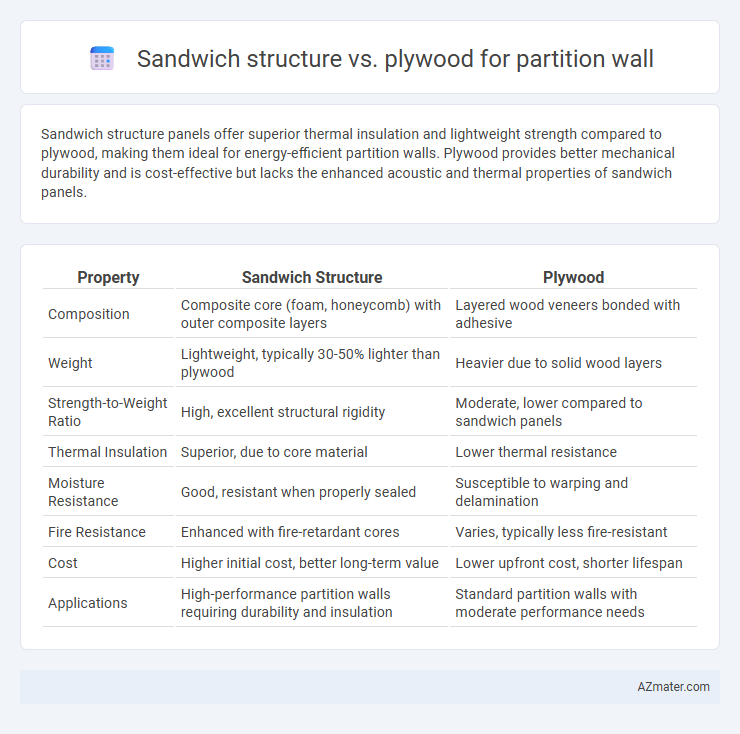Sandwich structure panels offer superior thermal insulation and lightweight strength compared to plywood, making them ideal for energy-efficient partition walls. Plywood provides better mechanical durability and is cost-effective but lacks the enhanced acoustic and thermal properties of sandwich panels.
Table of Comparison
| Property | Sandwich Structure | Plywood |
|---|---|---|
| Composition | Composite core (foam, honeycomb) with outer composite layers | Layered wood veneers bonded with adhesive |
| Weight | Lightweight, typically 30-50% lighter than plywood | Heavier due to solid wood layers |
| Strength-to-Weight Ratio | High, excellent structural rigidity | Moderate, lower compared to sandwich panels |
| Thermal Insulation | Superior, due to core material | Lower thermal resistance |
| Moisture Resistance | Good, resistant when properly sealed | Susceptible to warping and delamination |
| Fire Resistance | Enhanced with fire-retardant cores | Varies, typically less fire-resistant |
| Cost | Higher initial cost, better long-term value | Lower upfront cost, shorter lifespan |
| Applications | High-performance partition walls requiring durability and insulation | Standard partition walls with moderate performance needs |
Introduction: Comparing Sandwich Structure and Plywood for Partition Walls
Sandwich structure panels consist of two outer metal sheets bonded to a lightweight core, offering superior strength-to-weight ratio and thermal insulation compared to traditional plywood. Plywood, made from layered wood veneers, provides natural aesthetics and ease of installation but lacks the enhanced durability and moisture resistance of sandwich panels. Choosing between the two depends on requirements for structural performance, insulation properties, and environmental conditions in partition wall applications.
Overview of Partition Wall Materials
Partition walls commonly use sandwich structures and plywood as primary materials, each offering distinct advantages. Sandwich structures feature layered composites such as gypsum board, insulation, and metal sheets, providing superior thermal insulation, soundproofing, and lightweight properties. Plywood offers strength, durability, and ease of installation but may lack the enhanced acoustic and thermal performance found in advanced sandwich panels.
What is Sandwich Structure?
Sandwich structure consists of two outer layers of strong, rigid material bonded to a lightweight core, providing high strength-to-weight ratio and excellent insulation properties ideal for partition walls. Common core materials include foam, honeycomb, or balsa wood, while outer facings are typically aluminum, fiberglass, or plywood. Compared to plywood, sandwich panels offer superior thermal insulation, soundproofing, and durability, making them a preferred choice in modern construction for efficient partition solutions.
What is Plywood?
Plywood is a versatile engineered wood product made from thin layers of wood veneer glued together with grains alternating to enhance strength and durability. It offers high structural stability, resistance to warping, and excellent load-bearing capacity, making it ideal for partition walls in residential and commercial buildings. Compared to sandwich structures, plywood provides a more natural wood appearance and better fastening properties but may be heavier and less insulated.
Structural Strength Comparison
Sandwich structure panels offer superior structural strength for partition walls due to their high stiffness-to-weight ratio, achieved through a core material like foam or honeycomb bonded between two rigid face sheets. Plywood, while durable and flexible, generally provides lower load-bearing capacity and resistance to bending compared to engineered sandwich composites. The enhanced rigidity and impact resistance of sandwich structures make them a preferred choice for partition walls requiring greater structural integrity and long-term performance.
Thermal and Acoustic Insulation Properties
Sandwich structure panels generally offer superior thermal and acoustic insulation compared to plywood due to their multi-layer composition, often incorporating foam or mineral wool cores that enhance heat resistance and sound absorption. Plywood partitions provide moderate insulation but lack the specialized core materials that significantly reduce thermal conductivity and dampen noise transmission. For environments requiring enhanced energy efficiency and noise control, sandwich structure walls deliver more effective insulation performance than traditional plywood partitions.
Fire Resistance Analysis
Sandwich structures with fire-resistant cores, such as mineral wool or gypsum, demonstrate superior fire resistance compared to conventional plywood, which is highly combustible and prone to rapid flame spread. Fire resistance analysis highlights that sandwich panels maintain structural integrity and limit heat transfer during fire exposure, offering enhanced safety in partition walls. Plywood's organic composition accelerates charring and smoke production, making it less suitable for fire-sensitive environments.
Installation and Construction Efficiency
Sandwich structure panels offer faster installation for partition walls due to their lightweight core and pre-laminated surfaces, reducing labor time compared to traditional plywood. Prefabricated components in sandwich panels enable consistent dimensions, minimizing on-site adjustments and waste. In contrast, plywood requires careful handling, cutting, and securing, which can extend construction time and increase complexity during installation.
Cost-Effectiveness and Longevity
Sandwich structure panels offer superior cost-effectiveness over plywood for partition walls due to their lightweight core materials, which reduce transportation and installation expenses while maintaining structural integrity. The longevity of sandwich panels is enhanced by corrosion-resistant facings and moisture-resistant cores, providing greater durability in humid or high-traffic environments compared to plywood, which is prone to warping and termite damage. Investing in sandwich structure materials results in lower maintenance costs and longer service life, making them a more economical choice for long-term partition wall applications.
Best Applications and Recommendations
Sandwich structures offer superior thermal insulation and lightweight properties, making them ideal for temporary or movable partition walls in commercial spaces and offices. Plywood provides excellent strength, durability, and ease of customization, suited for permanent partitions in residential and high-traffic areas. For best results, use sandwich panels where energy efficiency and quick installation are priorities, while plywood is recommended for robust, long-term applications requiring structural integrity.

Infographic: Sandwich structure vs Plywood for Partition wall
 azmater.com
azmater.com